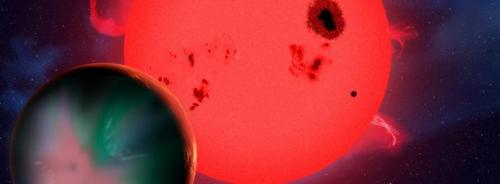Harsh Space Weather May Doom Potential Life on Red-Dwarf Planets
Life in the universe might be even rarer than we thought. Recently, astronomers looking for potentially habitable worlds have targeted red dwarf stars because they are the most common type of star, comprising 80 percent of the stars in the universe. But a new study shows that harsh space weather might strip the atmosphere of any rocky planet orbiting in a red dwarf's habitable zone.

"A red-dwarf planet faces an extreme space environment, in addition to other stresses like tidal locking," says Ofer Cohen of the Harvard-Smithsonian Center for Astrophysics (CfA).
Cohen is presenting their findings in a press conference at a meeting of the American Astronomical Society.
Earth is protected from solar eruptions and space weather by its magnetic field. Just like the shields of the Starship Enterprise, Earth's magnetic field deflects incoming energy blasts. We also are protected by distance since Earth orbits 93 million miles from the Sun.
Red dwarf stars are smaller and cooler than the Sun. To be in the star's habitable zone, where the temperature is warm enough for liquid water, a planet would have to be much closer to its star than the Earth is to the Sun. As a result, such a planet would be subjected to severe space weather.
Previous work has looked at the impact of stellar flares from a red dwarf on a nearby planet. In contrast, the new research examines the effect of the red dwarf's constantly blowing stellar wind. The team used a computer model developed at the University of Michigan to represent three known red-dwarf planets circling a simulated, middle-aged red dwarf.
They found that even an Earth-like magnetic field could not necessarily protect a habitable-zone world from the star's continuous bombardment. Although there were moments when the planet's magnetic shields held firm, it spent far more time with weak shields than strong shields.
"The space environment of close-in exoplanets is much more extreme than what the Earth faces," explains co-author Jeremy Drake (CfA). "The ultimate consequence is that any planet potentially would have its atmosphere stripped over time."
The extreme space weather also would trigger spectacular aurorae, or Northern Lights. The aurora on a red-dwarf planet could be 100,000 times stronger than those on Earth, and extend from the poles halfway to the equator.
"If Earth were orbiting a red dwarf, then people in Boston would get to see the Northern Lights every night," adds Cohen. "Oh the other hand, we'd also be in constant darkness because of tidal locking, and blasted by hurricane-force winds because of the dayside-nightside temperature contrast. I don't think even hardy New Englanders want to face that kind of weather."
Source:Harvard-Smithsonian Center for Astrophysics
- 411 reads
Human Rights
Ringing FOWPAL’s Peace Bell for the World:Nobel Peace Prize Laureates’ Visions and Actions

Protecting the World’s Cultural Diversity for a Sustainable Future

The Peace Bell Resonates at the 27th Eurasian Economic Summit

Declaration of World Day of the Power of Hope Endorsed by People in 158 Nations

Puppet Show I International Friendship Day 2020

